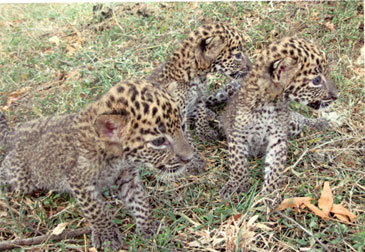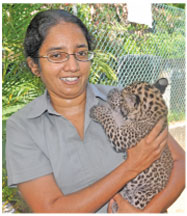|
'Spotlight' on conservation:
Leopard cubs steal the show
By Dhaneshi YATAWARA


The cubs when they were found on July 1 |

Director, National Zoo Bashwara Gunarathne |

Veterinarian-in-Charge Ganga Wijesinghe |
They are stunningly beautiful, adorable and extremely inquisitive.
The new logs set out for them to climb, the new wooden platform, the new
pond and everything in their new enclosure have made them excited and
hyperactive. This would surely continue for a few more days. The
antiques and tricks of the three leopard cubs easily attract the
attention of all those who visit the Dehiwela zoo. There was a lot of
leopard fascination for Sri Lankans last week as the three adorable
leopard cubs, rescued from illegal trade early July this year, were
shown to the public for the first time.
On July 1, wildlife officials of the North Western region received
three terrified leopard cubs through a local politician, supposedly
found in the Karuwalagas wewa area and kept by an illegal animal
trafficker. This area borders the Wilpattu National Park and the
Puttalam district.
Wildlife veterinarians assumed that the three cubs could be around
one and a half to two months old and had been without food or water for
a few days.
The fate of their mother was not known and as most people suspected,
she could have been killed, as a mother leopard would never isolate her
brood. Do they still remember the loss of their mother? No one knows,
but one thing that is certain is that they miss the warmth of their
mother; the one who would have understood them best and trained them to
grow up to strengthen their endangered family which is presently losing
its place in nature, without so much as a roar.
Now, almost six months, the three cuddly babies weigh 10 kg, 9.6kg
and 9.4kg, according to their Veterinarian-in-Charge Ganga Wijesinghe.
“Daily they are fed with chicken and beef alternately. Now we give them
two meals per day, but when they were younger they were given three
feeds,” she explained.
When we visited the zoo, it was the cubs' meal time. Caretaker
Piyasiri came with the tray of meat especially prepared for them and all
play stopped for a while. Then the little ones were taken in to the
adjoining room where the meat was placed in three separate plates.
“We add vitamins to the meat, since in captivity it is difficult to
give a whole carcass for these animals. In the wild these cubs get to
eat different parts of a full carcass and this would give them nutrition
of a broad spectrum. And they get meat from a variety of animals in the
jungle thus giving them an adequate vitamin and mineral supply,” Dr.
Wijesinghe said.
Various bacteria
Another reason why the cubs cannot be fed an entire carcass is the
presence of various bacteria in the internal parts of the carcass –
especially in the digestive tract. Thus, these cubs are provided fresh
meat that is not contaminated, where certain parts have been removed,
especially the intestines.
“Any big cat should gain 100 – 200 grams of weight per day and these
three cubs are showing the best results,” she said. The veterinarians of
the zoological garden take the body weight of the cubs on a daily basis.
The cubs falling sick would be a nightmare for the zoo staff. The
trio suffered from a food indigestion a few months ago and the chief
caretaker Ajith and Piyasiri had to bring porridge (kenda) from home for
the cubs, to prevent them from being dehydrated. Injections and saline
were continuously administered to these tender babies to save them from
the deadly disease proving that surviving in captivity is harder than in
the wild.
Despite all the comforts created for them through the painstaking
efforts of the Zoological Garden staff, the little ones would have
enjoyed a more free and pleasurable life in the wilds. Over the past
four months, they were adjusting to life in a new environment, away from
the wilderness. Yet, air-borne viral diseases, especially from domestic
cats, made them sick. Adding to this agony is the habit among many Sri
Lankans to abandon kittens in and around the Dehiwela zoo, considering
it a safe haven for their additional 'troubles'.
According to the vets, these cats carry many diseases to which the
bigger members of the cat family are not immune. Many such diseases are
deadly to these wild animals. Despite advances in technology and
medication, such diseases severely threaten the lives of these animals.
Conservation of species
As the veterinarians explain, in the wild, as the density of the cat
family is low and as most of these animals lead solitary lives, there
are less chances of them contracting such diseases.
While caring for 13 leopards at the Dehiwela zoo (including the three
female cubs), the Department of Zoological Gardens is moving towards a
long-term plan for the conservation of endemic and endangered species.
The first step would encompass leopards.
“Sri Lanka is well-known across the globe as one of the best places
to view free-roaming leopards,” said Director of the National Zoological
Gardens Department Bashwara Senanka Gunarathne. Under the project, two
leopard free roaming zones (safari type) will be built in Pinnawala and
Hambantota. A huge enclosure of 40 acres will be built for the leopards
in Hambantota.
“This will be the Conservation Centre for Endemic and Endangered
Species. Building the leopard enclosure is just the first step in this
drive and we are planning to build more such facilities for sloth bear,
African wild animals and Antarctic region animals. They all belong to
endemic and endangered groups,” Gunarathne explained. The facility under
construction in a land adjacent to the Pinnawala Elephant Orphanage
spreads over 12,267 sq.mt. The authorities plan to complete construction
by April 2012. The architectural and engineering expertise is from the
State Engineering Corporation; Rs. 43.9 million will be spent on the
project. “It would allow visitors to see leopards freely roaming in the
park from different angles. We are constructing two viewing decks which
will be inclusive of restaurants and souvenir shops. One viewing deck
will have an underground restaurant which too will give visitors a
different view of the leopards,” Gunarathne explained.
While priority is being given to leopard conservation by the
Government, a dreadful story emerges from the Yala National Park where a
young female leopard has been killed, run over by a vehicle. The carcass
was found on October 22 in the Patanangala area of the Park, around 6.00
am - soon after the park was opened to the public.
Referring to the post mortem report, Dr. Tharaka Prasad, Director
(Wildlife Health) of the Department of Wildlife Conservation said the
cause of death of the female leopard had been injuries due to a
vehicular accident. Its rib cage and associated muscles were severely
damaged due to the blow to the left of its chest. The vehicle had run
over its tail. The Department of Wildlife has requested a detailed
report from the Warden of the Yala National Park. Investigations are
continuing.
Free roaming leopards
It is one of the best places on earth to see free roaming leopards,
local and foreign tourists flock to the Yala National Park everyday. The
enthusiasm of the visitors is sometimes misused by the safari vehicle
drivers, inflicting harm on the innocent wild animals in the protected
area. In the rush to satisfy their customers, these drivers would speed
to a location where a leopard has been sighted according to other
drivers.
The visitors should understand that the animals are not on display,
that they are in their natural habitat where they have to find water to
quench their thirst and find prey to survive.
Disturbing their natural behaviour brings disaster on the entire
eco-system, forcing the animals to move away from visitor roaming
tracks.
Normally, during the drought season the Wildlife Department closes
the parks to the public for two main reasons; one is that the animals
have to roam long distances to find water and food and secondly to carry
out park management and maintenance programs. The true sense of
wilderness could only be enjoyed if the visitor too is willing to be a
part of that environment. Accepting to abide by the law of the jungle is
a must for any nature lover. Rather than pointing an accusing finger at
the authorities, the nature lover who visits these parks also has a role
to play. In such a disciplined environment, the survival of leopards and
other endangered species will not be so convoluted. |

